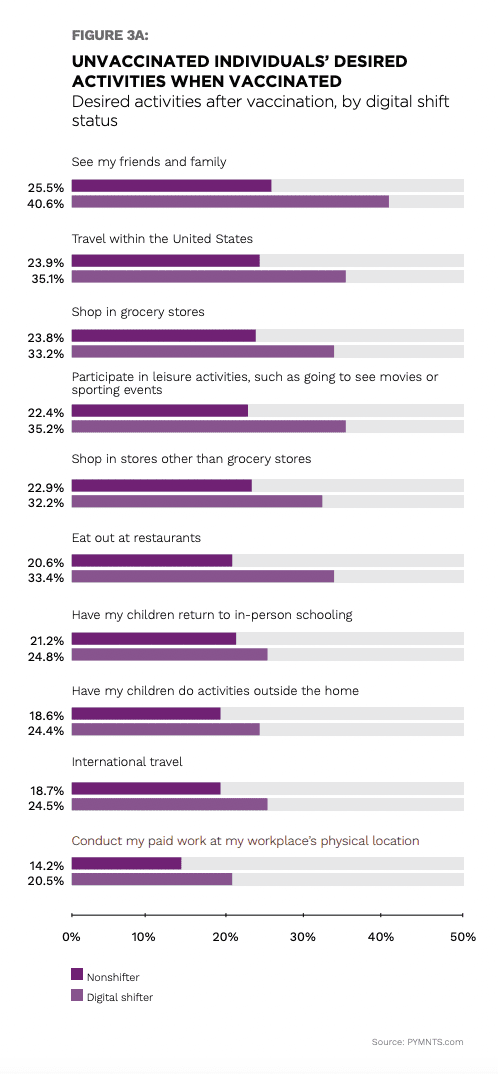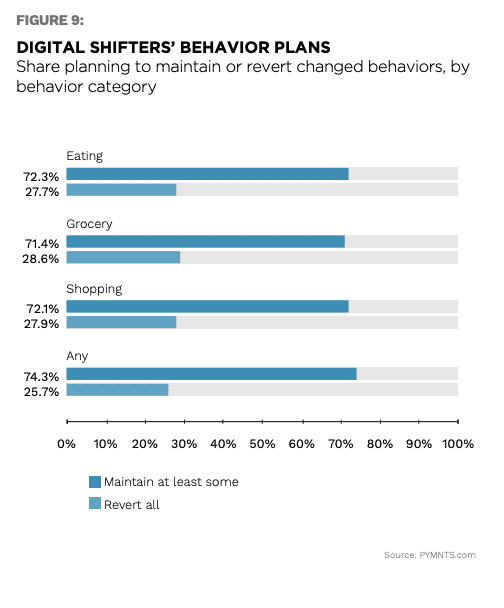An exclusive new research report from PYMNTS reveals that three-fourths of consumers plan to keep at least some of the eCommerce habits they picked up during the pandemic. The findings come as roughly 60 percent of the population has had at least their first dose of a COVID-19 vaccine, as states across the country are rolling back their mask mandates and other restrictions on public places.
 According to PYMNTS’ new survey data, Consumers and the New Retail Landscape, consumers remain most excited to see their families and friends again, closely followed by traveling in the U.S., shopping in stores, dining out and getting their kids back into school. Consumers have also become less concerned about the impact of COVID-19 on their and their families’ lives (53 percent), down from a high of 72 percent in July of 2020.
According to PYMNTS’ new survey data, Consumers and the New Retail Landscape, consumers remain most excited to see their families and friends again, closely followed by traveling in the U.S., shopping in stores, dining out and getting their kids back into school. Consumers have also become less concerned about the impact of COVID-19 on their and their families’ lives (53 percent), down from a high of 72 percent in July of 2020.
And that excitement to get back out there is visible beyond reported consumer sentiment. Flight bookings are on the rise, dining in person without distancing restrictions is coming back and summer vacation season is widely forecast to be something of a barn-burner in 2021 as consumers rush back out to enjoy real-world activities once again.
But that rush back might be a bit more measured than some are forecasting. As much as consumers want to get back to their public lives, the data suggests that they are actually getting back out there at a somewhat slower rate than reported, particularly when compared to their non-digitally shifting counterparts. For example, about 25 percent of non-shifters reported that they were more likely to see friends and family in the event of a vaccine becoming available, a number that pretty closely aligns with the roughly 22 percent of non-shifters who have actually gotten back out there. However, that close alignment disappears with digital shifters: 40 percent of them reported that a vaccine would enable them to see friends and family more, yet only about 20.2 percent have actually done so.
The reason for this breaks down into a few explanations. Some are still hesitant to return to familiar activities, while others have found that their old activities have become less attractive over time as compared to their digital counterparts. But the upshot of the data is the same, it seems: The digital shifters are hesitant to dive back into their old lives, even when the immediate threat posed by infection is removed from the equation.
In fact, the data seems to demonstrate that despite the availability of the vaccine and the relaxing of restrictions on store and restaurant hours across the country, many respondents still value the efficiency of their new habits over the old — particularly when it comes to the delivery of food and groceries. As CEO Andrew Robbins told Karen Webster in a recent conversation, eating out (for real) is coming back, but the delivery boom is far from fading out.
Advertisement: Scroll to Continue
 “We’re at one of these inflection points where people are asking, ‘what’s going to happen in the future?’” said Robbins. “Because one could imagine that with a return to [on-premise dining], online ordering should go down. But what we’re seeing in our numbers is that it’s part of some people’s lifestyle that they would like to keep.”
“We’re at one of these inflection points where people are asking, ‘what’s going to happen in the future?’” said Robbins. “Because one could imagine that with a return to [on-premise dining], online ordering should go down. But what we’re seeing in our numbers is that it’s part of some people’s lifestyle that they would like to keep.”
In fact, the data demonstrates that some 72 percent of consumers plan to hold onto at least some of their digital dining habits, a similar share to those who plan to maintain at least some of their new digital habits when it comes to shipping or getting their groceries. Three-quarters of digital shifters state that they will maintain at least one behavioral change they acquired during this eventful year.
This is unsurprising, as consumers — who spend an average of 16 hours per day online consuming digital media — would have little incentive to abandon digital behaviors that are at their fingertips and save them time.
Read More On Digital Shift:

 According to PYMNTS’ new survey data,
According to PYMNTS’ new survey data,  “We’re at one of these inflection points where people are asking, ‘what’s going to happen in the future?’” said Robbins. “Because one could imagine that with a return to [on-premise dining], online ordering should go down. But what we’re seeing in our numbers is that it’s part of some people’s lifestyle that they would like to keep.”
“We’re at one of these inflection points where people are asking, ‘what’s going to happen in the future?’” said Robbins. “Because one could imagine that with a return to [on-premise dining], online ordering should go down. But what we’re seeing in our numbers is that it’s part of some people’s lifestyle that they would like to keep.”


